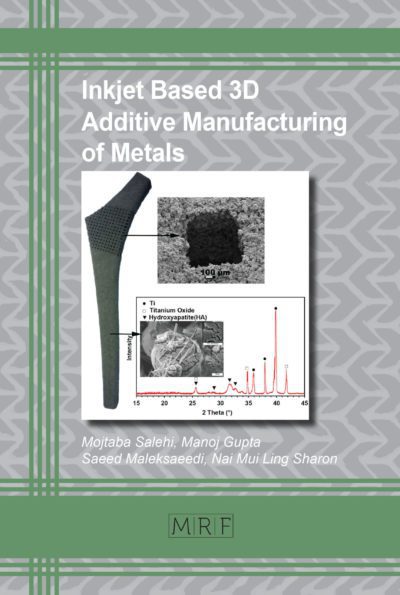Investigations on material extrusion process for zirconia filled with a partially bio-based polymer
Delphine AUZENE, Marwa ABID, Mohamed BOUDIFA, Sébastien CHARLON, Luc ORDINSKI, Marie-France LACRAMPE, Thierry BARRIERE
Abstract. Material Extrusion (MEX) has become an attractive technique for producing filaments for additive manufacturing of complex, low-volume, customized parts. It is an innovative approach to manufacturing ceramic or metal parts by extruding and depositing layer by layer a hot filament made from granules (raw material) or composite filaments. The printed parts are then debinded and sintered to produce the final parts. In this work, a new environmentally friendly raw material was developed from zirconia and partially biobased polymers. Models describing the thermal degradation of polymers were used to calculate the activation energy associated with debinding, and to design the optimal thermal debinding program based on thermogravimetric analysis (TGA). Finally, digital imaging and X-ray tomography were used to characterize the internal morphology of sintered parts.
Keywords
Material Extrusion, 3D Printing, Additive Manufacturing, Ceramic, Zirconia, Bio-Based Binders, Debinding, Sintering
Published online 5/7/2025, 8 pages
Copyright © 2025 by the author(s)
Published under license by Materials Research Forum LLC., Millersville PA, USA
Citation: Delphine AUZENE, Marwa ABID, Mohamed BOUDIFA, Sébastien CHARLON, Luc ORDINSKI, Marie-France LACRAMPE, Thierry BARRIERE, Investigations on material extrusion process for zirconia filled with a partially bio-based polymer, Materials Research Proceedings, Vol. 54, pp 322-329, 2025
DOI: https://doi.org/10.21741/9781644903599-35
The article was published as article 35 of the book Material Forming
![]() Content from this work may be used under the terms of the Creative Commons Attribution 3.0 license. Any further distribution of this work must maintain attribution to the author(s) and the title of the work, journal citation and DOI.
Content from this work may be used under the terms of the Creative Commons Attribution 3.0 license. Any further distribution of this work must maintain attribution to the author(s) and the title of the work, journal citation and DOI.
References
[1] G. Herranz, C. Berges, J. Hidalgo, Material Extrusion Additive Technologies: Benefits, Challenges, and Niche Applications, IntechOpen, 2025, https://doi.org/10.5772/intechopen.1008718
[2] J. Gonzalez-Gutierrez, S. Cano, S. Schuschnigg, C. Kukla, J. Sapkota, C. Holzer, Additive Manufacturing of Metallic and Ceramic Components by the Material Extrusion of Highly-Filled Polymers: A Review and Future Perspectives, Materials, vol. 11, no 5, Art. no 5, 2018, https://doi.org/10.3390/ma11050840
[3] C. Rigollet, D. Moinard, Procédés de frittage PIM, in Techniques de l’Ingénieur, vol. M3320, 2011, https://doi.org/10.51257/a-v1-m3320
[4] M. C. Auscher, R. Fulchiron, N. Fougerouse, T. Périé, P. Cassagnau, Zirconia based feedstocks : Influence of particle surface modification on the rheological properties, Ceramics International, vol. 43, no 18, p. 16950‐16956, déc. 2017, https://doi.org/10.1016/j.ceramint.2017.09.100
[5] Q. He, Additive manufacturing of dense zirconia ceramics by fused deposition modeling via screw extrusion, Journal of the European Ceramic Society, vol. 41, no 1, p. 1033‐1040, janv. 2021, https://doi.org/10.1016/j.jeurceramsoc.2020.09.018
[6] G. Chen, P. Cao, G. Wen, N. Edmonds, Debinding behaviour of a water-soluble PEG/PMMA binder for Ti metal injection moulding, Materials Chemistry and Physics, vol. 139, no 2, p. 557‑565, mai 2013, https://doi.org/10.1016/j.matchemphys.2013.01.057
[7] A. Hadian, L Koch, P Koberg, F Sarraf, A Liersch, T Sebastian, F Clemens, Material extrusion based additive manufacturing of large zirconia structures using filaments with ethylene vinyl acetate based binder composition, Additive Manufacturing, Volume 47, November 2021, 102227, https://doi.org/10.1016/j.addma.2021.102227
[8] T. Ozawa, A New Method of Analyzing Thermogravimetric Data, BCSJ, vol. 38, no 11, p. 1881‑1886, nov. 1965, https://doi.org/10.1246/bcsj.38.1881.
[9] H. L. Friedman, Kinetics of thermal degradation of char-forming plastics from thermogravimetry. Application to a phenolic plastic, Journal of Polymer Science Part C: Polymer Symposia, vol. 6, no 1, p. 183‑195, janv. 1964, https://doi.org/10.1002/polc.5070060121.
[10] H. E. Kissinger, Reaction Kinetics in Differential Thermal Analysis, Analytical Chemistry, Vol 29/Issue 11, nov.1957, https://doi.org 10.1021/ac60131a045
[11] M. Salehi, F. Clemens, T. Graule, B. Grobéty, Kinetic analysis of the polymer burnout in ceramic thermoplastic processing of the YSZ thin electrolyte structures using model free method, Applied Energy, vol. 95, p. 147‑155, juill. 2012, https://doi.org/10.1016/j.apenergy.2012.02.025
[12] M. J. G. Fait, E. Moukhina, M. Feist, H.-J. Lunk, Thermal decomposition of ammonium paratungstate tetrahydrate: New insights by a combined thermal and kinetic analysis, Thermochimica Acta, vol. 637, p. 38‑50, 2016, https://doi.org10.1016/j.tca.2016.05.009
[13] S. Vyazovkin, ICTAC Kinetics Committee recommendations for analysis of multi-step kinetics, Thermochimica Acta, vol. 689, p. 178597, juill. 2020, https://doi.org/ 10.1016/j.tca.2020.178597
[14] Q. Spiller, J. Fleischer, Additive manufacturing of metal components with the ARBURG plastic freeforming process, CIRP Annals, vol. 67, no 1, p. 225‑228, janv. 2018, https://doi.org/10.1016/j.cirp.2018.04.104
[15] R. M. German, Injection molding of metals and ceramics, Powder Metallurgy 42 157-160, vol. 3, 1997, https://doi.org/10.4271/982417
[16] I.M. Somasundram, A Cendrowicz, DI Wilson, ML Johns Phenomenological study and modelling of wick debinding, Chemical Engineering Science, Volume 63, Issue 14, July 2008, Pages 3802-3809, https://doi.org/10.1016/j.ces.2008.04.040
[17] K. S. Hwang, T. H. Tsou, Thermal debinding of powder injection molded parts: Observations and mechanisms, Metall Trans A, vol. 23, no 10, p. 2775‐2782, oct. 1992, https://doi.org/10.1007/BF02651756













